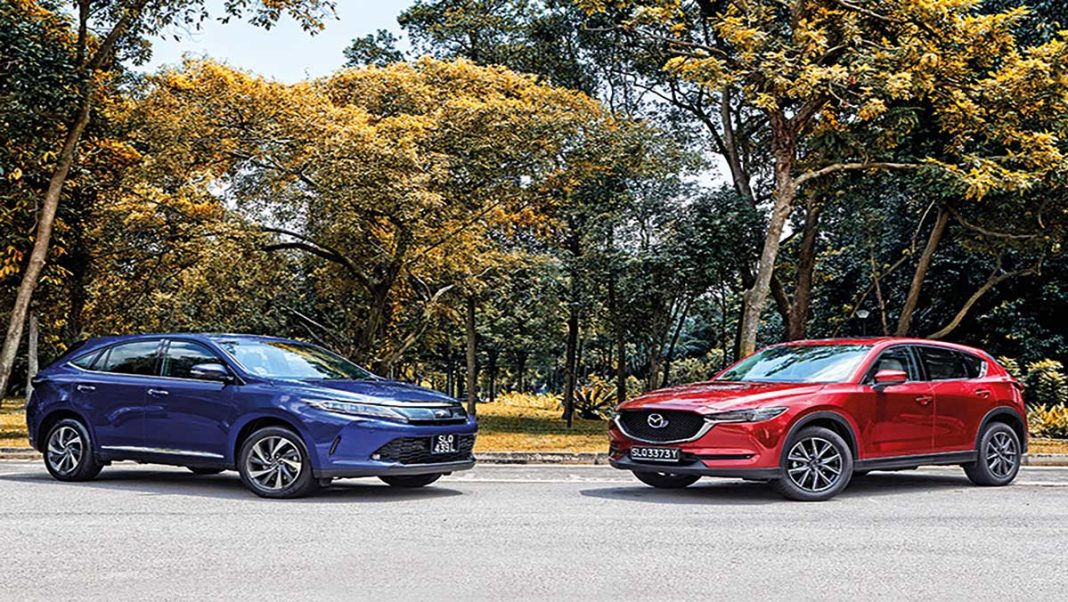Mazda CX-5 and the Toyota Harrier are currently at the top of the latest generation of mid-size SUVs. Since SUVs are among the most popular car types nowadays, it is impossible to avoid them on your daily commute.
Everything from enormous luxury models to small compacts appear to be available for everyone. Now is the best moment to purchase a sport utility vehicle (SUV).
They are now a major factor for drivers here because they are more reasonably priced and have all the cutting-edge technology and performance that were previously only found in cars twice as expensive.
The official Toyota Harrier is powered by a 2.0 turbocharged engine, which tackles the SUV’s most significant flaw: its lack of torque. Mazda recently introduced the second generation CX-5.
Featuring their now-famous SKYACTIV-G technology, in which their engines work at higher compression to generate more power, as well as a slew of previously unseen technological innovations designed to improve fuel economy.
Mazda is also touting the benefits of their G-Vectoring Control technology (first seen in the redesigned Mazda 6). Essentially, because most automobiles are now throttle-by-wire, it is easy to use an array of sensors and electronics to carefully modify throttle inputs (which you cannot feel while driving).
Mazda does this for weight transference, better weight loading to the best wheels, and improved driving dynamics. In essence, occupants benefit from a more level and comfortable ride.
The 2.0 turbo engine in the Toyota Harrier produces 227bhp and 350Nm of torque at 1,650rpm. Power delivery is smooth, and with maximum torque feeding at this low in the rev range, the wait for the turbo to spool up is quite short.
All of this is routed through a six-speed automatic transmission and only drives the front wheels.
Mazda’s 2.5-liter engine produces 192bhp and, due to its normally aspirated nature, torque builds up, peaking at 257Nm at 3,250rpm. The CX-5, like the Harrier, has six ratios for driving the front wheels.
The increased torque and power delivered by the turbocharged Toyota 2.0 makes the Harrier a joy to drive, especially when accelerating from city to highway speeds.
All of this is adequately delivered by Mazda’s 2.5-liter engine, but you can feel the engine working harder just to do the same job.
While the Harrier is heavier, its force-fed engine accelerates it to 100km/h in 7.3 seconds, compared to Mazda’s 8.9 seconds.
Handling & Design
While the Toyota is quite agile in terms of weight transfer around corners, the Mazda actually does a much better job, thanks to their G-Vectoring Control technology.
Externally, the CX-5’s styling distinguishes it from the competition. Mazda’s current design philosophy of “KODO – Soul of Motion” incorporates purposeful folds in the sheet metal.
The window-to-body ratio is a pleasing 1:2, giving the car higher shoulders and sleek-looking windows. The look is completed by carefully placed chrome trim bits around the windows and around that gaping front grille.
Toyota Harrier, too, has done an excellent job with its exterior appearance. A split grille that extends most of the way to the front bumper visibly lifts the front end of the vehicle.
Running lights and fog lamps are integrated with a few smart tucks and folds. In contrast to the Mazda CX-5’s near parallel to the roofline windows, the Harrier has downward sloping windows that begin to taper downward midway at the rear doors, giving it a sportier stance.
The Harrier has a lot of black slick plastic paneling on the inside. There are also printed carbon fiber designs, which detract from the car’s overall appearance. When compared to the Mazda CX 5, the infotainment unit feels more aftermarket and like an afterthought.
While it has a lot of functions, it does weirdly flip open with the screen facing up to display the DVD player. Closing this would be difficult because the upward facing screen now displays the virtual shut button, which you cannot see.
Mazda CX 5, on the other hand, has less clutter, with the infotainment device proudly perched on top of the dashboard. With a cleaner UI, navigation is also lot easier. The built-in BOSE system with 10 speakers and a subwoofer unit discreetly stowed away in the space saver spare was one of the Mazda CX 5’s standout features.
When it comes to seat comfort, the Harrier outperforms the other two vehicles. The Toyota Harrier has a significantly larger feeling of room, especially in the back. Mazda’s chairs feel more costly and are unquestionably more supportive, but they lack the lounge-like relaxation that Toyota provides.
Both vehicles have a similar boot area, with the Harrier having 440 liters and the Mazda CX 5 having 442 liters. Both vehicles have flat folding seats, with the Toyota Harrier folding them 60:40 and the CX-5 folding them 40:20:40. Both automobiles’ boot lids are automatic.
Toyota provides a car that is suitable for cruising; the drive is less exciting with this car. While the Harrier provides the best comfort of the two vehicles, it falls short in terms of interior build quality and refinement.
Mazda’s engine may not be as powerful in this situation, but the way the car has been put together, especially how it handles, the materials used, and yes, the paint quality that Mazda has always been known for, makes the Mazda CX-5 a better prospect.

